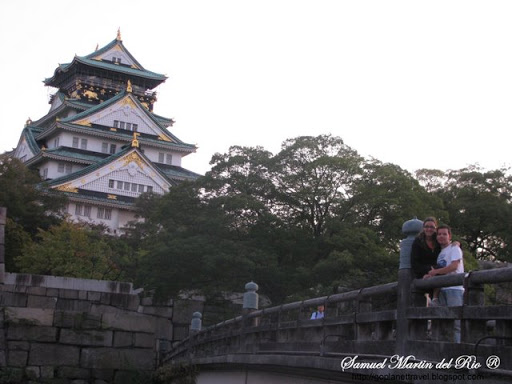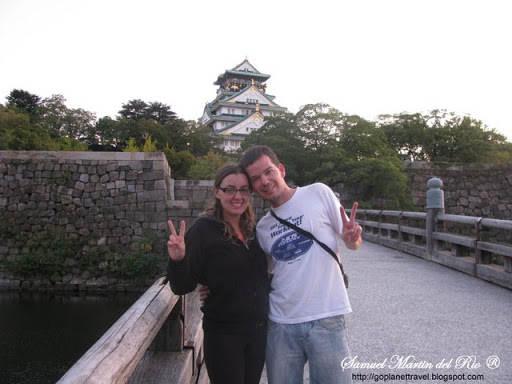My YOUTUBE video of OSAKA
 Osaka is a city in Japan, located at the mouth of the Yodo River on Osaka Bay, in the Kansai region of the main island of Honshū.
Osaka is a city in Japan, located at the mouth of the Yodo River on Osaka Bay, in the Kansai region of the main island of Honshū.
Osaka is a City in Japan and also is designated city under the Local Autonomy Law and the capital city of Osaka Prefecture. Osaka has historically been the commercial capital of Japan, and is at the heart of Japan's second largest metropolitan area of Keihanshin (Osaka-Kobe-Kyoto), whose population is 18,643,915.
The ratio between daytime and night time population is 141%, the highest in Japan, highlighting its status as an economic center. Its nighttime population is 2.6 million, the third in the country, but in daytime the population surges to 3.7 million, second only after Tokyo. Osaka has traditionally been referred to as the "nation's kitchen", or the Mecca of gourmet food.

Some of the earliest signs of habitation in the area of Osaka were found at the Morinomiya remains, with its shell mounds, including sea oysters and buried human skeletons from the 5th–6th centuries BC. It is believed that what is today the Uehonmachi area consisted of a peninsular land, with an inland sea in the east. During the Yayoi period, permanent habitation on the plains grew as rice farming became popular.
By the Kofun period, Osaka developed into a hub port connecting the region to the western part of Japan. The large numbers, and the increasing size, of tomb mounds found in the plains of Osaka are seen as evidence of political-power concentration, leading to the formation of a state.

In 645, Emperor Kōtoku built his palace, the Naniwa Nagara-Toyosaki Palace in Osaka, making this area the capital (Naniwa-kyō). The place that became the modern city was by this time called Naniwa. This name, and derived forms, are still in use for districts in central Osaka such as Naniwa and Namba . Although the capital was moved to Asuka in 655, Naniwa remained a vital connection, by land and sea, between Yamato (modern day Nara Prefecture), Korea, and China.
In 744, Naniwa once again became the capital by order of Emperor Shōmu. Naniwa ceased to be the capital in 745, when the Imperial Court moved back to Heijō-kyō (now Nara). The seaport function was gradually taken over by neighboring lands by the end of Nara period, but it remained a lively center of river, channel, and land transportation between Heian-kyō (Kyoto today) and other destinations.

In 1496, the Jōdo Shinshū Buddhist sect set up their headquarters in the heavily fortified Ishiyama Hongan-ji on the site of the old Naniwa imperial palace. Oda Nobunaga started a siege of the temple in 1570. After a decade, the monks finally surrendered, and the temple was razed, and Toyotomi Hideyoshi constructed Osaka Castle in its place.
Osaka was, for a long time, Japan's most important economic center, with a large percentage of the population belonging to the merchant class. Over the course of the Edo period (1603–1867), Osaka grew into one of Japan's major cities and returned to its ancient role as a lively and important port. Its popular culture was closely related to ukiyo-e depictions of life in Edo. Developing in parallel with the urban culture of Kyoto and Edo, Osaka likewise featured bunraku and grand kabuki productions, pleasure quarters, and a lively artistic community.

In 1837, Ōshio Heihachirō, a low-ranking samurai, led a peasant insurrection in response to the city's unwillingness to support the many poor and suffering families in the area. Approximately one-quarter of the city was razed before shogunal officials put down the rebellion, after which Ōshio killed himself.
Osaka was opened to foreign trade by the government of the Bakufu at the same time as Hyōgo (modern Kobe) on 1 January 1868, just before the advent of the Boshin war and the Meiji restoration.
The modern municipality was established in 1889 by government ordinance, with an initial area of 15 km², overlapping today's Chūō and Nishi wards. Later, the city went through three major expansions to reach its current size of 222 km².
October 2009
 Osaka is a city in Japan, located at the mouth of the Yodo River on Osaka Bay, in the Kansai region of the main island of Honshū.
Osaka is a city in Japan, located at the mouth of the Yodo River on Osaka Bay, in the Kansai region of the main island of Honshū.Osaka is a City in Japan and also is designated city under the Local Autonomy Law and the capital city of Osaka Prefecture. Osaka has historically been the commercial capital of Japan, and is at the heart of Japan's second largest metropolitan area of Keihanshin (Osaka-Kobe-Kyoto), whose population is 18,643,915.
The ratio between daytime and night time population is 141%, the highest in Japan, highlighting its status as an economic center. Its nighttime population is 2.6 million, the third in the country, but in daytime the population surges to 3.7 million, second only after Tokyo. Osaka has traditionally been referred to as the "nation's kitchen", or the Mecca of gourmet food.

Some of the earliest signs of habitation in the area of Osaka were found at the Morinomiya remains, with its shell mounds, including sea oysters and buried human skeletons from the 5th–6th centuries BC. It is believed that what is today the Uehonmachi area consisted of a peninsular land, with an inland sea in the east. During the Yayoi period, permanent habitation on the plains grew as rice farming became popular.
By the Kofun period, Osaka developed into a hub port connecting the region to the western part of Japan. The large numbers, and the increasing size, of tomb mounds found in the plains of Osaka are seen as evidence of political-power concentration, leading to the formation of a state.

In 645, Emperor Kōtoku built his palace, the Naniwa Nagara-Toyosaki Palace in Osaka, making this area the capital (Naniwa-kyō). The place that became the modern city was by this time called Naniwa. This name, and derived forms, are still in use for districts in central Osaka such as Naniwa and Namba . Although the capital was moved to Asuka in 655, Naniwa remained a vital connection, by land and sea, between Yamato (modern day Nara Prefecture), Korea, and China.
In 744, Naniwa once again became the capital by order of Emperor Shōmu. Naniwa ceased to be the capital in 745, when the Imperial Court moved back to Heijō-kyō (now Nara). The seaport function was gradually taken over by neighboring lands by the end of Nara period, but it remained a lively center of river, channel, and land transportation between Heian-kyō (Kyoto today) and other destinations.

In 1496, the Jōdo Shinshū Buddhist sect set up their headquarters in the heavily fortified Ishiyama Hongan-ji on the site of the old Naniwa imperial palace. Oda Nobunaga started a siege of the temple in 1570. After a decade, the monks finally surrendered, and the temple was razed, and Toyotomi Hideyoshi constructed Osaka Castle in its place.
Osaka was, for a long time, Japan's most important economic center, with a large percentage of the population belonging to the merchant class. Over the course of the Edo period (1603–1867), Osaka grew into one of Japan's major cities and returned to its ancient role as a lively and important port. Its popular culture was closely related to ukiyo-e depictions of life in Edo. Developing in parallel with the urban culture of Kyoto and Edo, Osaka likewise featured bunraku and grand kabuki productions, pleasure quarters, and a lively artistic community.

In 1837, Ōshio Heihachirō, a low-ranking samurai, led a peasant insurrection in response to the city's unwillingness to support the many poor and suffering families in the area. Approximately one-quarter of the city was razed before shogunal officials put down the rebellion, after which Ōshio killed himself.
Osaka was opened to foreign trade by the government of the Bakufu at the same time as Hyōgo (modern Kobe) on 1 January 1868, just before the advent of the Boshin war and the Meiji restoration.
The modern municipality was established in 1889 by government ordinance, with an initial area of 15 km², overlapping today's Chūō and Nishi wards. Later, the city went through three major expansions to reach its current size of 222 km².
October 2009
You have read this article with the title OSAKA, JAPAN. You can bookmark this page URL http://oinsweden.blogspot.com/2009/10/osaka-japan.html. Thanks!
Write by:
AN - Wednesday, October 28, 2009






.jpg)



Comments "OSAKA, JAPAN"
Post a Comment